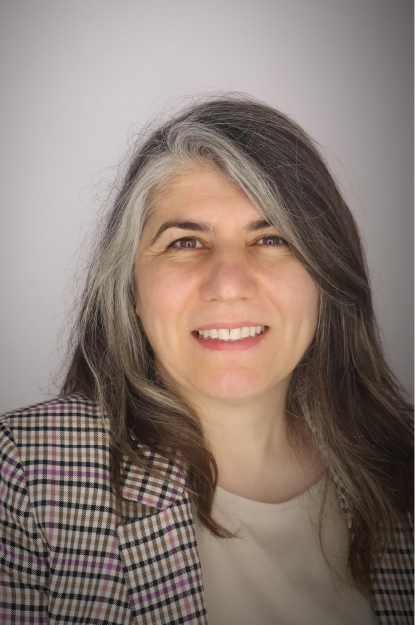S. Selcen GuzeyProfessor25% Biological Sciences, 75% Curriculum & Instruction 765-494-9749 BRNG 4160 sguzey@purdue.edu |

|
PROFESSIONAL FACULTY RESEARCH
Dr. Guzey’s research on integrated STEM education focuses on design, implementation, and evaluation of engineering design-based science teaching and learning strategies.
BIO
Dr. Guzey is a Professor of Science Education, with joint appointments in the Departments of Curriculum and Instruction and Biological Sciences. She joined Purdue in 2014 as part of a faculty cluster-hire initiative focused on integrated STEM education. Her work integrates research, teaching, and engagement with a central aim of advancing STEM education. In recognition of her impactful research, she was appointed in 2016 as Associate Director of Research Initiatives at Purdue’s Center for Advancing the Teaching and Learning of STEM (CATALYST). Dr. Guzey is a University Faculty Scholar and currently serves as Head of the Department of Curriculum and Instruction.
Education
|
Ph.D.
|
Science Education, University of Minnesota, Minneapolis, MN |
| M.A. | Science Education, University of Minnesota, Minneapolis, MN |
| B.S. | Biology, Hacettepe University, Ankara, Turkey |
Selected Projects
Silicon Crossroads Microelectronics Commons Hub, Applied Research Institute, SCALE K-12, $2,500,000. Co-PI.
Department of Defense and Indiana Economic Development Corporation, SCALE K-12, $6,000,000. Co-PI.
U.S. Department of Education, Indy STEM Teacher Residency, 2019-2024, $5,072,651. Co-PI.
NSF, DRK-12, LifeSTEM: Integration of Engineering Design and Life Science: Investigating the Influence of an Intervention on Student Interest and Motivation in STEM Fields, $1,838,015. PI.
NSF, NOYCE, Project Einstein: Excellence in STEM teaching in Indiana, 2018-2023, $1,415,500 . .
Indiana Commission for Higher Education, Strengthening Indiana’s Future through the 21st Century STEM Teachers Scholarship Program, 2016-2021, $688,000. Co-PI.
NSF, MSP, EngrTEAMS: Engineering to Transform the Education of Analysis, Measurement, and Science in Team-Based Targeted Mathematics-Science Partnership 2013-2019, $7,998,001. Co-PI.
Selected Publications
Tran, K. & Guzey S. S. (2024). Good intentions are not enough: A case study uncovering the perpetuation of internalized and interpersonal oppression in a middle school STEM classroom. Journal of Research in Science Teaching, 61(3), 706-735.
Taylor, J., Bowen, M., Kubsch, M., Sezen-Barrie, A., Ryan, S., Patricia, P., Lachapelle, C., Warfa, A., & Guzey, S. S. (2023). Crossing boundaries between research and practitioner communities: The role of research use and cross-community journal authorship. Journal of Research in Science Teaching, 61(7), 1727-1754.
Tran, K. & Guzey S. S. (2023). Cultivating culturally sustaining STEM classrooms: A narrative inquiry case study of a science teacher. Science Education, 107(6), 1507-1530.
Guzey, S. S. & Li, W. (2023). A longitudinal study of middle school students’ science learning in the context of integrated STEM instruction. Journal of Science Education and Technology, 32(2), 168-180.
Anwar, S., Menekse, M., Guzey, S. S. , & Bryan, L. (2022). The effectiveness of an integrated STEM curriculum unit on middle school students’ life science learning. Journal of Research in Science Teaching, 59(7), 1204-1234.
Guzey, S. S. & Yoon, J. (2021). Productive thinking in engineering design. International
Journal of Science and Mathematics Education, 9 , 215-232. https://doi.org/10.1007/s10763...
Siverling, E., Moore, T., Suazo, E., Mathis, C., Guzey, S. S. (2021). What initiates evidence-
based reasoning?: Situations that prompt students to justify their design ideas and decisions. Journal of Engineering Education, 10 (2), 294-317. https://doi.org/10.1002/jee.20384
Guzey, S. S. , Caskurlu, S., & Kozan, K. (2020). Integrated STEM education approaches and
Handbook of Research on STEM Education (pp. 65-75). Routledge.
Dubinsky, J., Guzey, S. S. , Schwartz M. S., Roehrig, G., MacNabb, C., et al. (2019).
Contributions of neuroscience knowledge to teachers and their practice. The
Neuroscientist , 25 (5), 394-407. https://doi.org/10.1177/1073858419835447
Aranda, M., Guzey, S. S. & Moore, T. J. (2019). Multidisciplinary discourses in
engineering design-based science curricular unit. International Journal of Technology and Design Education, 30 (3), 507-529. https://doi.org/10.1007/s10798...
Johnston, A. C., Akarsu, M. G., Moore, T., & Guzey, S. S. (2019). Engineering as the
integrator: A case study of one middle school science teacher’s talk. Journal of Engineering Education , 108 , 418-440. https://doi.org/10.1002/jee.20...
Lie, R., Aranda, M., Guzey, S. S. , Moore, T. (2019). Students’ views of design in an
engineering design-based science curriculum unit. Research in Science Education , 51, 663-683. https://doi.org/10.1007/s11165...
Guzey, S. S. & Ring, B. (2018). Negotiating science and engineering: An exploratory case
International Journal of Science Education, 40(7), 723-741. https://doi.org/10.1080/095006...
Guzey, S. S. & Aranda, M. (2017). Student participation in engineering practices and discourse:
Journal of Engineering Education, 106, 585-606. https://doi.org/10.1002/jee.20...
Courses
|
EDCI
|